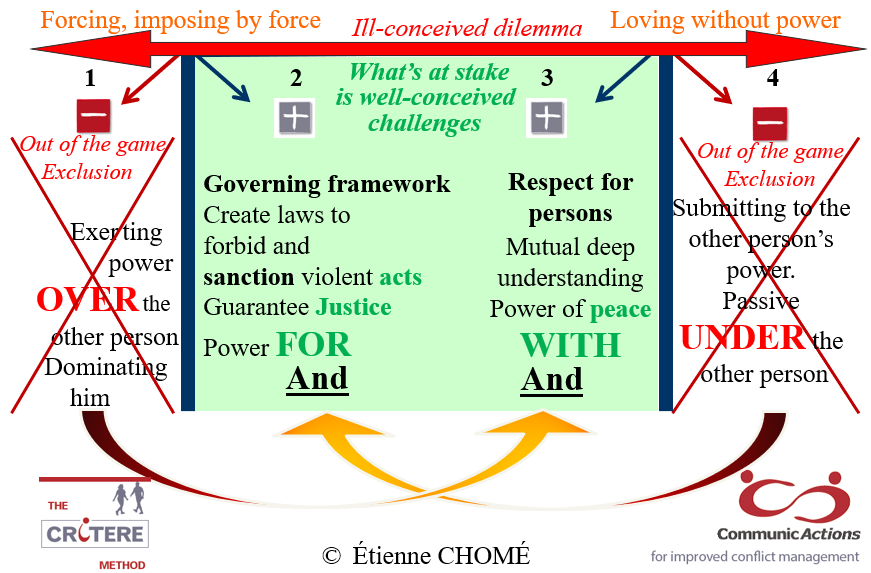Here are the first lines of my book: The New Paradigm of Non-Violence:
Is it possible to effectively counteract violence by means other than violence? How can one exercise the « right » of legitimate self-defence without being drawn into the terrible trap of becoming part of the conflict – without becoming an accomplice to the violence of the aggressor? Is this question different for individuals in their interpersonal relationships than it is for human societies in their international relations?
Certainly, taking responsibility in the midst of this violent world is to assume a part in the battle that will require a certain power. Love without power is powerlessness. Authority without sanction is laissez-faire. Passivity produces the worst conflict scenarios. Impunity is the breeding ground for the worst abuses of power. To love someone is not to let them do harm. However, at the other end of the spectrum, how much anger and how many ‘holy’ wars are gangrenous with the evil they claim to be fighting? Where is the dividing line between the power of domination, which contains the seed of destructive violence, and legitimate forces based on law, which are respectful of people and capable of building justice in a context of love?
« Violence » and « non-violence » are two operative concepts that crystallise a paradigm shift. One use of the term « violence » is to push back the line of the « lesser evil » that is tolerated. At the end of the 20th century, « violence » became an operative concept that was used within some human groups to stigmatise practices in order to better ostracize those that had lost their integrity, legitimacy or necessity. For example, in ‘countries embracing human rights’, it was tolerated – not so long ago – that, to curb a child’s indiscipline, a parent could use a whip, or lock the child in a dark cellar for a whole night. As these practices have crossed the threshold of unacceptability, today, in the name of children’s rights, countries are saying no to corporal punishment as a means of education. The value of the operative concept is to mobilise the group: behaviour that shocks people’s consciences because it has become humanly contemptible will only be outlawed through changes in awareness, and a long maturation on the moral, cultural and psychological levels. Each member of the group will be effectively confronted with his or her responsibilities when on the political level legislation outlaws the act described as ‘violent’, and the law is accompanied by sanctions.
A teacher who hits a child today, is disapproved of and sanctioned, however well-meaning his intention, however just his cause. In fact, his action is the expression of a tragic powerlessness. If he were sufficiently trained in conflict management, he would find resources other than physical violence in order to exercise his authority and obtain effective respect for the rules. The objective of the principle of non-violence is to formalise a clear and precise limit for all:
« Whatever the end pursued or the extenuating circumstances, physical violence towards a child is a mistake and a counterproductive action. It is unjustifiable, it is prohibited.”
Once the action is recognised as intrinsically wrong, the so-called ‘non-violent’ alternatives that have existed all along, become obligatory. The « non » of « non-violence » means STOP to violence. It is much more than a negation. It is a « no » to rupture and to combat; it is a mobilising « no » in refusing the fatality of violence. Thus, this dynamic is of great practical fertility in pushing back against customs that have been tolerated until now, as lesser evils.
This dynamic also affects international relations, even if it is less easily apprehended there. The violence of states, linked to their sacrosanct sovereignty and “raison d’Etat”, is diminishing as human groups manage to eliminate their various forms of honour, of ideological justification and the idea of inescapable necessity. Are there still just wars? In any case, consciences are becoming increasingly aware of the role of lies and propaganda in justified wars!
The hypothesis at the beginning of this essay is that the capacity of men to progressively outlaw violence gives rise to a new paradigm of thought, which can be summed up in a formula: the challenge of our time is to learn how to exercise force without violence. In understanding this new paradigm, the activist philosopher Jean-Marie Muller, born in 1939, was the first in the French-speaking world to state: « The ‘non’ that non-violence opposes to violence is a ‘no’ of resistance. Non-violence is certainly abstention, but this abstention itself requires action. […] It is a question of creating a dynamic that aims to limit, reduce and, as far as possible, eliminate violence, starting with the reality of violence that we are used to considering as necessary and legitimate. There is a chain reaction of economic, social, political and police violence that cannot be interrupted if at any point in the process violence is legitimised. To break the logic of violence, a political dynamic must be created that reverses the process of the violent development of conflicts. It is this dynamic that the political philosophy of non-violence invites us to implement.
Below is the conceptual framework I have invented to mark out the path: leave the horizontal line of the ill-posed dilemma to pose a double vertical: where do the lines pass that separate, on the one hand, violence (column 1) and passivity, its accomplice (column 4) and, on the other hand, the non-violent forces of law (column 2) and love (column 3)? Then, how can columns 2 and 3 be increased, while continually reducing 1 and 4?
